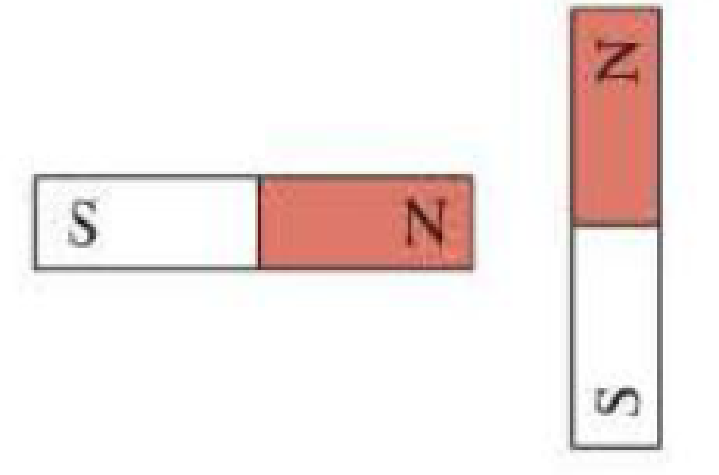
Concept explainers
In Figure Q24.1, suppose the magnet on the right is fixed in place and the magnet on the left is free to pivot about its center. Will the magnet on the left start to rotate? If so, will it initially rotate clockwise or counterclockwise?
Figure Q24.1

To check: the left side magnet’s rotation and find the initial rotating direction of this magnet.
Answer to Problem 1CQ
The left side magnet starts rotating and it is rotating in the direction of clockwise.
Explanation of Solution
Given data:
Refer Figure Q24.1 in the textbook for two magnet arrangement.
Consider that the north pole of the magnet is expressed as “N” and the south pole of the magnet is expressed as “S”.
Explanation:
Consider the same poles of magnets repel each other and opposite poles of magnets attract each other.
The magnet, which is placed in the left side, will rotate in direction of clockwise because two N poles of the two magnets repel each other and the N pole of left magnet gets attracted by the S pole of right magnet. Then, the left magnet’s S pole is attracted to the N pole of the fixed magnet.
Therefore, the left magnet gets rotating due to opposite poles attraction and same poles repel.
Conclusion:
Thus, the left side magnet starts rotating and it is rotating in the direction of clockwise.
Want to see more full solutions like this?
Chapter 24 Solutions
COLLEGE PHYSICS:STRATEGIC APPR.AP ED.
Additional Science Textbook Solutions
Cosmic Perspective Fundamentals
Physics for Scientists and Engineers: A Strategic Approach, Vol. 1 (Chs 1-21) (4th Edition)
Introductory Chemistry (6th Edition)
Biology: Life on Earth (11th Edition)
Campbell Essential Biology (7th Edition)
Applications and Investigations in Earth Science (9th Edition)
- Problem Eight. A snowmobile is originally at the point with position vector 31.1 m at 95.5° counterclockwise from the x-axis, moving with velocity 4.89 m/s at 40.0°. It moves with constant acceleration 1.73 m/s² at 200°. After 5.00 s have elapsed, find the following. 9.) The velocity vector in m/s. (A)=-4.38+0.185ĵ (D) = 0.185 +4.38ĵ (B)=0.1851-4.38ĵ (E) = 4.38 +0.185ĵ (C) v=-0.1851-4.38ĵ (A)=-39.3-4.30ĵ 10.) The final position vector in meters. (B)=39.3-4.30ĵ (C) = -4.61 +39.3ĵ (D) = 39.31 +4.30ĵ (E) = 4.30 +39.3ĵarrow_forwardProblem Seven. A football receiver running straight downfield at 5.60 m/s is 11.5 m in front of the quarterback when a pass is thrown downfield at an angle of 35.0° above the horizon. 8.) If the receiver never changes speed and the ball is caught at the same height from which it was thrown, find the distance between the quarterback and the receiver when the catch is made. (A) 21.3 (B) 17.8 (C) 18.8 (D) 19.9 (E) 67.5arrow_forward3 Consider a ball sliding down a ramp as shown above. The ball is already in motion at the position 1. Which direction best approximates the direction of instantaneous velocity vector V when the object is at position 3?arrow_forward
- No chatgpt plsarrow_forwardA car in a roller coaster moves along a track that consists of a sequence of ups and downs. Let the x axis be parallel to the ground and the positive y axis point upward. In the time interval from t 0 tot = = 4s, the trajectory of the car along a certain section of the track is given by 7 = A(1 m/s)ti + A [(1 m/s³) t³ - 6(1 m/s²)t²]ĵ where A is a positive dimensionless constant. At t car ascending or descending? = 2.0 S is the roller coaster Ascending. Descending.arrow_forwardneed help on first part its not 220arrow_forward
 College PhysicsPhysicsISBN:9781305952300Author:Raymond A. Serway, Chris VuillePublisher:Cengage Learning
College PhysicsPhysicsISBN:9781305952300Author:Raymond A. Serway, Chris VuillePublisher:Cengage Learning College PhysicsPhysicsISBN:9781285737027Author:Raymond A. Serway, Chris VuillePublisher:Cengage Learning
College PhysicsPhysicsISBN:9781285737027Author:Raymond A. Serway, Chris VuillePublisher:Cengage Learning Principles of Physics: A Calculus-Based TextPhysicsISBN:9781133104261Author:Raymond A. Serway, John W. JewettPublisher:Cengage Learning
Principles of Physics: A Calculus-Based TextPhysicsISBN:9781133104261Author:Raymond A. Serway, John W. JewettPublisher:Cengage Learning
 Physics for Scientists and Engineers, Technology ...PhysicsISBN:9781305116399Author:Raymond A. Serway, John W. JewettPublisher:Cengage Learning
Physics for Scientists and Engineers, Technology ...PhysicsISBN:9781305116399Author:Raymond A. Serway, John W. JewettPublisher:Cengage Learning Physics for Scientists and Engineers: Foundations...PhysicsISBN:9781133939146Author:Katz, Debora M.Publisher:Cengage Learning
Physics for Scientists and Engineers: Foundations...PhysicsISBN:9781133939146Author:Katz, Debora M.Publisher:Cengage Learning





